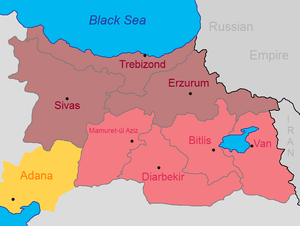Armenian reform package
The Armenian reform package was a reform plan devised by the European powers in 1912-14 that envisaged the creation of two provinces in Turkish Armenia placed under the supervision of two European inspectors general, who would be appointed to oversee matters related to the Armenian issues.[1][2] The inspectors general would hold the highest position in the six eastern vilayets (provinces), where the bulk of the Armenian population lived, and would reside at their respective posts in Erzurum and Van. The reform package was signed into law on February 8, 1914,[3] though it was ultimately abolished on December 16, 1914, several weeks after Turkey's entry into World War I.

Background
The Balkan wars had created an opportunity for the revival of new plans to improve the conditions of the Ottoman Armenians. The French, British and Italians were anxious to limit German influence in the Ottoman Empire, while the Russian government encouraged the Catholicos of Armenia to appeal through the viceroy of the Caucasus to the Ottoman government for intervention in favor of reforms in Armenian-inhabited vilayets. This project was prepared by André Mandelstam, the dragoman at the Russian Embassy in Istanbul, and representatives from the Armenian national assembly. It was introduced and discussed in Constantinople at a meeting of the ambassadors of France, Britain and Italy.
The project suggested the formation of a single province from six vilayets (Erzurum, Van, Bitlis, Diyarbakır, Kharput and Sivas) under either an Ottoman Christian or a European governor general. The governor general was to be appointed by the Powers for the ensuing five years. Germany opposed the project and succeeded in obtaining significant modifications, including splitting the region into two provinces.[4]
Plan
The reform package was signed on February 8, 1914, between the Ottoman Empire (represented by Grand Vezir Said Halim Pasha)[5] and Russia. Louis Constant Westenenk, an administrator for the Dutch East Indies, and Nicolai Hoff, a major in the Norwegian Army, were selected as the first two inspectors.[6] Hoff was in Van when the war broke out, just as Westenenk was preparing to depart for his post in Erzurum.[7][8]
Notes
- Davison, Roderic H. "The Armenian Crisis, 1912-1914," The American Historical Review 53 (Apr., 1948), pp. 481-505.
- (in Armenian) Karapetyan, N. V. (1981). "Հայկական բարենորոգումների խնդիրը 1912-14 թվականներին" [The Issue of the Armenian Reforms in the Years 1912-14] in Հայ Ժողովրդի Պատմություն [History of the Armenian People], eds. Tsatur Aghayan et al. Yerevan: Armenian Academy of Sciences, vol. 6, pp. 520-35.
- Hovannisian, Richard G. (1967). Armenia on the Road to Independence, 1918. Berkeley: University of California Press. pp. 38–39. ISBN 0-520-00574-0.
- Reynolds, Michael A. (2011). Shattering Empires: The Clash and Collapse of the Ottoman Empires, 1908-1918. Cambridge: Cambridge University Press, pp. 73-77.
- Şeyhun, Ahmed. "Said Halim and the Armenian Reform Project of 1914," Journal of the Society for Armenian Studies 19/2 (2010), pp. 93-108.
- Kévorkian, Raymond (2011). The Armenian Genocide: A Complete History. London: I. B. Tauris, p. 171.
- Hovannisian. Armenia on the Road to Independence, p. 39.
- L. C. Westenek, "Diary Concerning the Armenian Mission," Armenian Review 39 (Spring 1986), pp. 29-89.